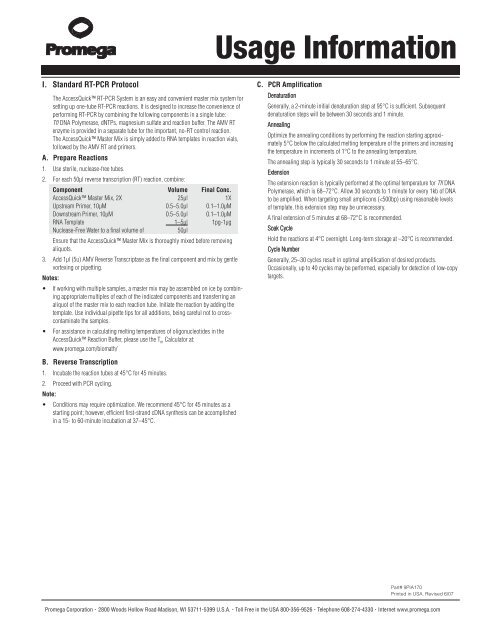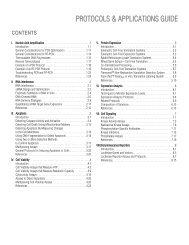AccessQuick(TM) RT-PCR System Product Information ... - Promega
AccessQuick(TM) RT-PCR System Product Information ... - Promega
AccessQuick(TM) RT-PCR System Product Information ... - Promega
Create successful ePaper yourself
Turn your PDF publications into a flip-book with our unique Google optimized e-Paper software.
I. Standard <strong>RT</strong>-<strong>PCR</strong> Protocol<br />
The <strong>AccessQuick</strong> <strong>RT</strong>-<strong>PCR</strong> <strong>System</strong> is an easy and convenient master mix system for<br />
setting up one-tube <strong>RT</strong>-<strong>PCR</strong> reactions. It is designed to increase the convenience of<br />
performing <strong>RT</strong>-<strong>PCR</strong> by combining the following components in a single tube:<br />
Tfl DNA Polymerase, dNTPs, magnesium sulfate and reaction buffer. The AMV <strong>RT</strong><br />
enzyme is provided in a separate tube for the important, no-<strong>RT</strong> control reaction.<br />
The <strong>AccessQuick</strong> Master Mix is simply added to RNA templates in reaction vials,<br />
followed by the AMV <strong>RT</strong> and primers.<br />
A. Prepare Reactions<br />
1. Use sterile, nuclease-free tubes.<br />
2. For each 50µl reverse transcription (<strong>RT</strong>) reaction, combine:<br />
Component Volume Final Conc.<br />
<strong>AccessQuick</strong> Master Mix, 2X 25µl 1X<br />
Upstream Primer, 10µM 0.5–5.0µl 0.1–1.0µM<br />
Downstream Primer, 10µM 0.5–5.0µl 0.1–1.0µM<br />
RNA Template 1–5µl 1pg-1µg<br />
Nuclease-Free Water to a final volume of 50µl<br />
3.<br />
Ensure that the <strong>AccessQuick</strong> Master Mix is thoroughly mixed before removing<br />
aliquots.<br />
Add 1µl (5u) AMV Reverse Transcriptase as the final component and mix by gentle<br />
vortexing or pipetting.<br />
Notes:<br />
If working with multiple samples, a master mix may be assembled on ice by combining<br />
appropriate multiples of each of the indicated components and transferring an<br />
aliquot of the master mix to each reaction tube. Initiate the reaction by adding the<br />
template. Use individual pipette tips for all additions, being careful not to crosscontaminate<br />
the samples.<br />
For assistance in calculating melting temperatures of oligonucleotides in the<br />
<strong>AccessQuick</strong> Reaction Buffer, please use the Tm Calculator at:<br />
www.promega.com/biomath/<br />
B. Reverse Transcription<br />
1. Incubate the reaction tubes at 45°C for 45 minutes.<br />
2. Proceed with <strong>PCR</strong> cycling.<br />
Note:<br />
Conditions may require optimization. We recommend 45°C for 45 minutes as a<br />
starting point; however, efficient first-strand cDNA synthesis can be accomplished<br />
in a 15- to 60-minute incubation at 37–45°C.<br />
Usage <strong>Information</strong><br />
C. <strong>PCR</strong> Amplification<br />
Denaturation<br />
Generally, a 2-minute initial denaturation step at 95°C is sufficient. Subsequent<br />
denaturation steps will be between 30 seconds and 1 minute.<br />
Annealing<br />
Optimize the annealing conditions by performing the reaction starting approximately<br />
5°C below the calculated melting temperature of the primers and increasing<br />
the temperature in increments of 1°C to the annealing temperature.<br />
The annealing step is typically 30 seconds to 1 minute at 55–65°C.<br />
Extension<br />
The extension reaction is typically performed at the optimal temperature for Tfl DNA<br />
Polymerase, which is 68–72°C. Allow 30 seconds to 1 minute for every 1kb of DNA<br />
to be amplified. When targeting small amplicons (

















